当前位置:网站首页>图解八道经典指针笔试题
图解八道经典指针笔试题
2022-07-05 08:31:00 【命由己造~】
第一题
int main()
{
int a[5] = {
1, 2, 3, 4, 5 };
int *ptr = (int *)(&a + 1);
printf( "%d,%d", *(a + 1), *(ptr - 1));
return 0; }
//程序的结果是什么?
a与ptr的内存图:
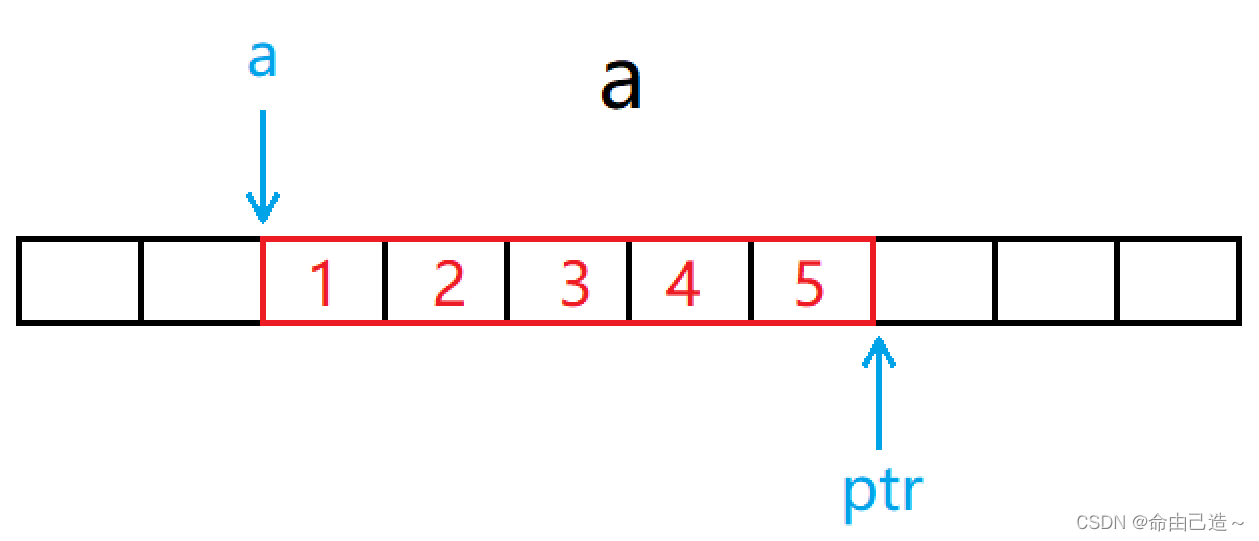
a + 1和 ptr - 1: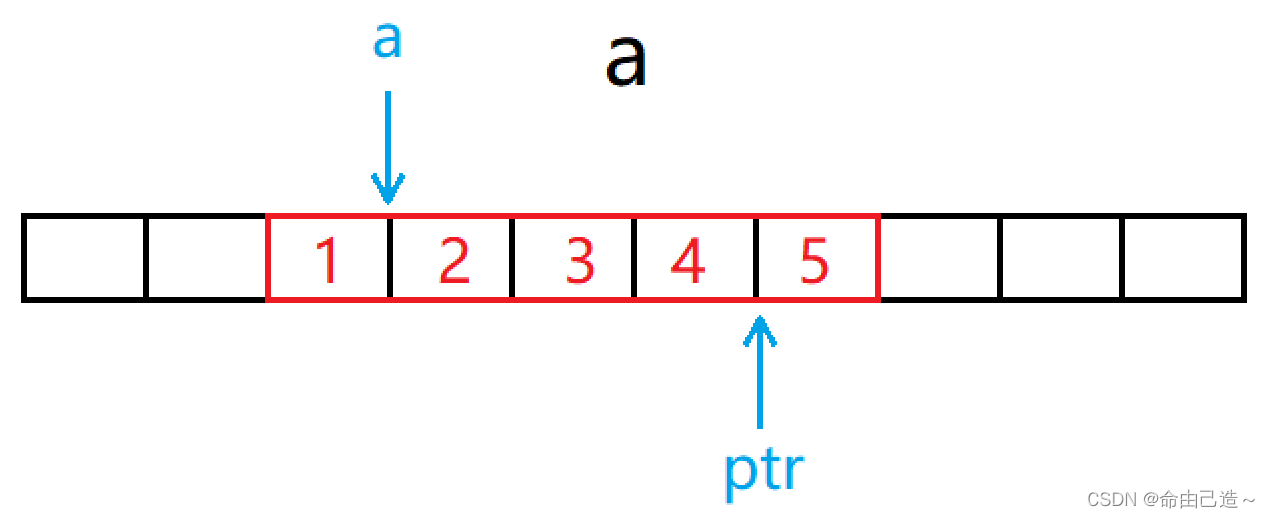
解引用后答案为:
2,5
第二题
struct Test
{
int Num;
char* pcName;
short sDate;
char cha[2];
short sBa[4];
}*p = 0x100000;
//假设p 的值为0x100000。 如下表表达式的值分别为多少?
int main()
{
printf("%p\n", p + 0x1);
printf("%p\n", (unsigned long)p + 0x1);
printf("%p\n", (unsigned int*)p + 0x1);
return 0;
}
本题涉及结构体大小的计算,有遗忘的小伙伴可以看一看:结构体/联合体大小的计算
此结构体的大小为20字节
这道题首先要知道指针加整数要看指针类型,而整数加整数就可以直接加p+0x1 就是跳过一个p类型大小,就相当于+20(unsigned long)p + 0x1 俩整数相加,直接加(unsigned int*)p + 0x1 跳过p类型大小,相当于+4
最后答案为:
0x100020
0x100001
0x100004
第三题
int main()
{
int a[4] = {
1, 2, 3, 4 };
int *ptr1 = (int *)(&a + 1);
int *ptr2 = (int *)((int)a + 1);
printf( "%x,%x", ptr1[-1], *ptr2);
return 0;
}
ptr1跟第一题一样,要注意的是ptr2,(int)a + 1中的+1是加一个字节,而一个整形有四个字节,a是首元素地址,(int)a + 1后:
而因为ptr2是int* 类型,所以解引用时要向后看四个字节:
小端存储取出来后就为02 00 00 00
最后的答案为:
4, 2000000(16进制不打印前面的0)
第四题
int main()
{
int a[3][2] = {
(0, 1), (2, 3), (4, 5) };
int *p;
p = a[0];
printf( "%d", p[0]);
return 0;
}
这里有个陷阱:逗号表达式
真正的内存图: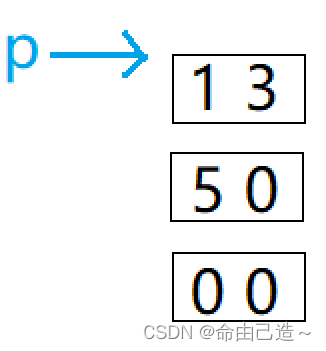
最后的答案为:
1
第五题
int main()
{
int a[5][5];
int(*p)[4];
p = a;
printf( "%p,%d\n", &p[4][2] - &a[4][2], &p[4][2] - &a[4][2]);
return 0;
}
a[4][2]很好找,但是p[4][2]不好找,p指针的类型是int(*)[4],p[4][2]可以看做: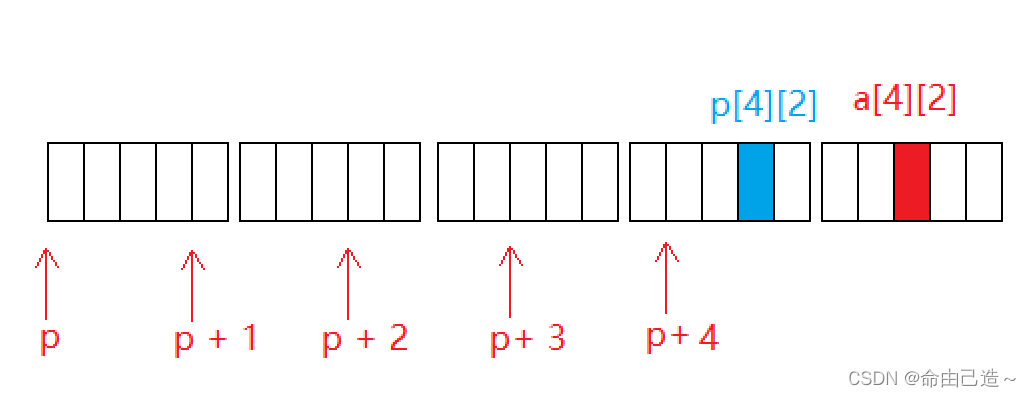
&p[4][2] - &a[4][2]结果是-4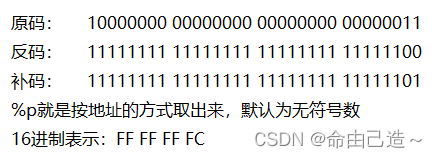
所以答案为:
FF FF FF FC , -4
第六题
int main()
{
int aa[2][5] = {
1, 2, 3, 4, 5, 6, 7, 8, 9, 10 };
int* ptr1 = (int*)(&aa + 1);
int* ptr2 = (int*)(*(aa + 1));
printf("%d,%d", *(ptr1 - 1), *(ptr2 - 1));
return 0;
}
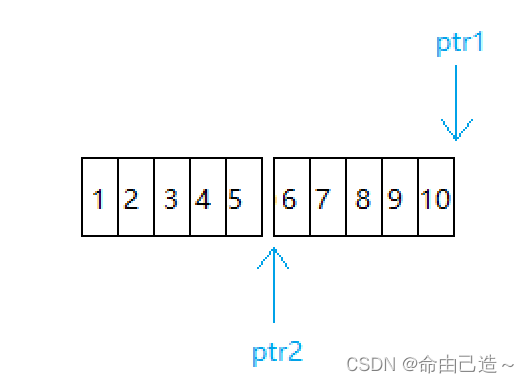
答案:
10, 5
第七题
int main()
{
char* a[] = {
"work","at","alibaba" };
char** pa = a;
pa++;
printf("%s\n", *pa);
return 0;
}
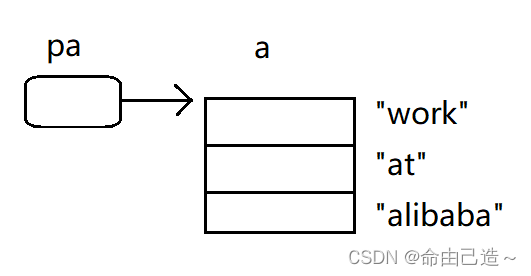
pa++后指向的a指向"at"
答案为:
“at”
第八题
int main()
{
char* c[] = {
"ENTER","NEW","POINT","FIRST" };
char** cp[] = {
c + 3,c + 2,c + 1,c };
char*** cpp = cp;
printf("%s\n", **++cpp);
printf("%s\n", *-- * ++cpp + 3);
printf("%s\n", *cpp[-2] + 3);
printf("%s\n", cpp[-1][-1] + 1);
return 0;
}
先把图画出来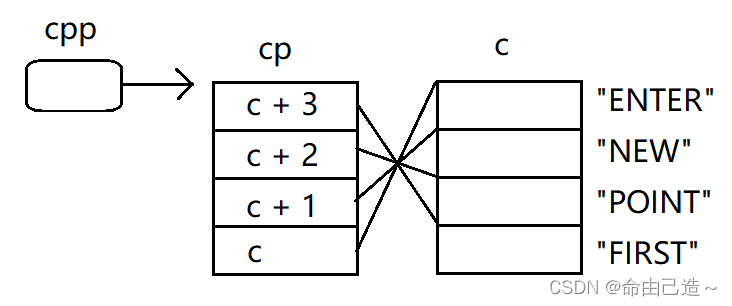
因为打印函数中存在++和- -,会改变下一步的结果,所以要一步步分析
1️⃣**++cpp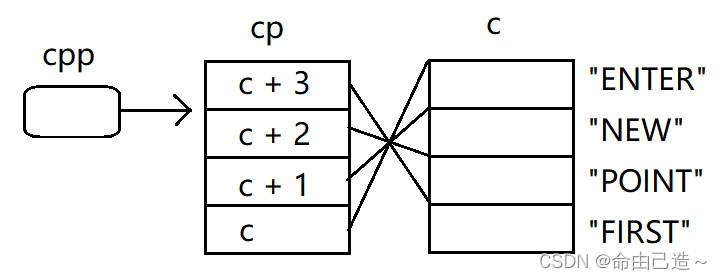
指向的是"POINT"
2️⃣*-- * ++cpp + 3
①++cpp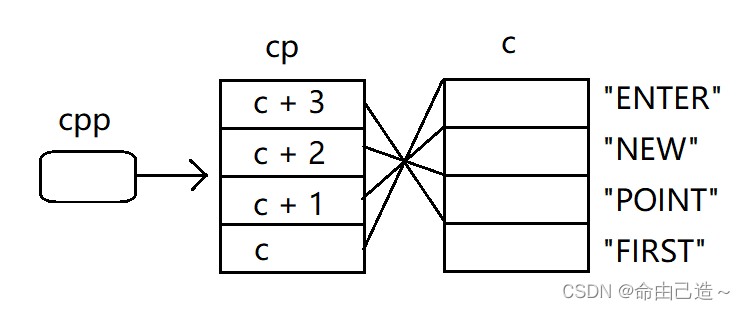
②-- * ++cpp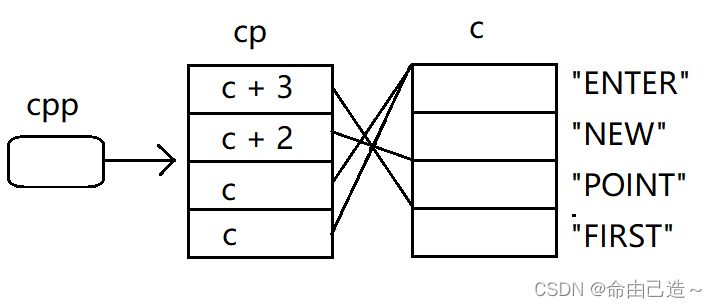
③*-- * ++cpp + 3
指向的为"ER"
3️⃣*cpp[-2] + 3
 指向的为
指向的为"ST"
4️⃣cpp[-1][-1] + 1
①cpp[-1]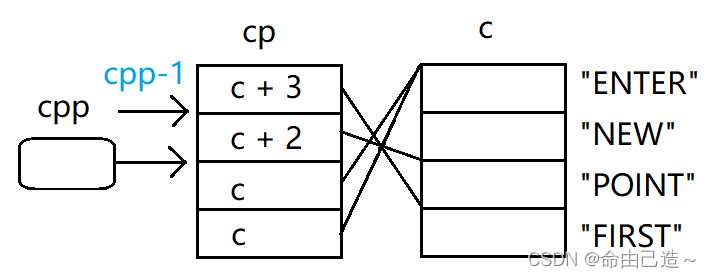
②cpp[-1][-1]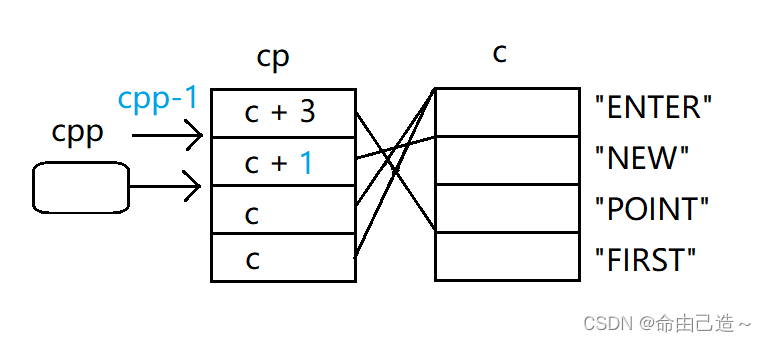
③cpp[-1][-1] + 1
指向的为"EW"
所以答案为:
POINT
ER
ST
EW
边栏推荐
- Use indent to format code
- Daily question - input a date and output the day of the year
- 【三层架构】
- Meizu Bluetooth remote control temperature and humidity access homeassistant
- MATLAB小技巧(28)模糊综合评价
- Keil use details -- magic wand
- Synchronization of QT multithreading
- Stablq of linked list
- 【三层架构及JDBC总结】
- Briefly talk about the identification protocol of mobile port -bc1.2
猜你喜欢
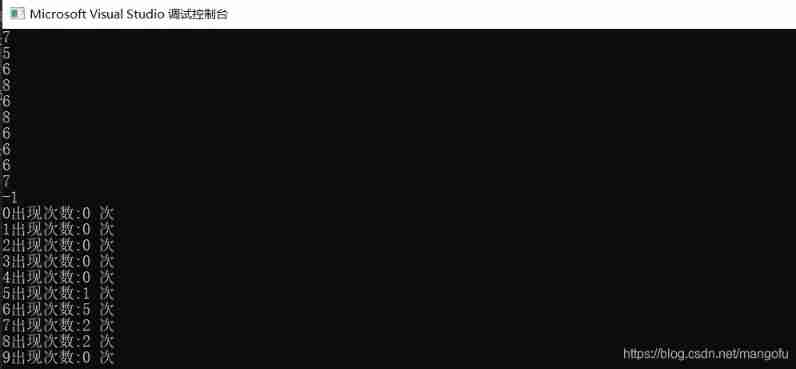
Count the number of inputs (C language)
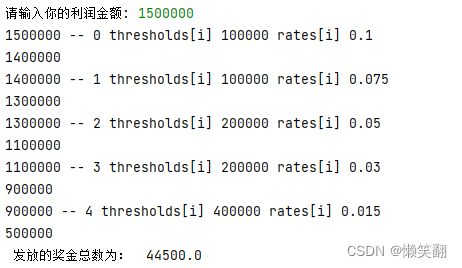
实例002:“个税计算” 企业发放的奖金根据利润提成。利润(I)低于或等于10万元时,奖金可提10%;利润高于10万元,低于20万元时,低于10万元的部分按10%提成,高于10万元的部分,可提成7.
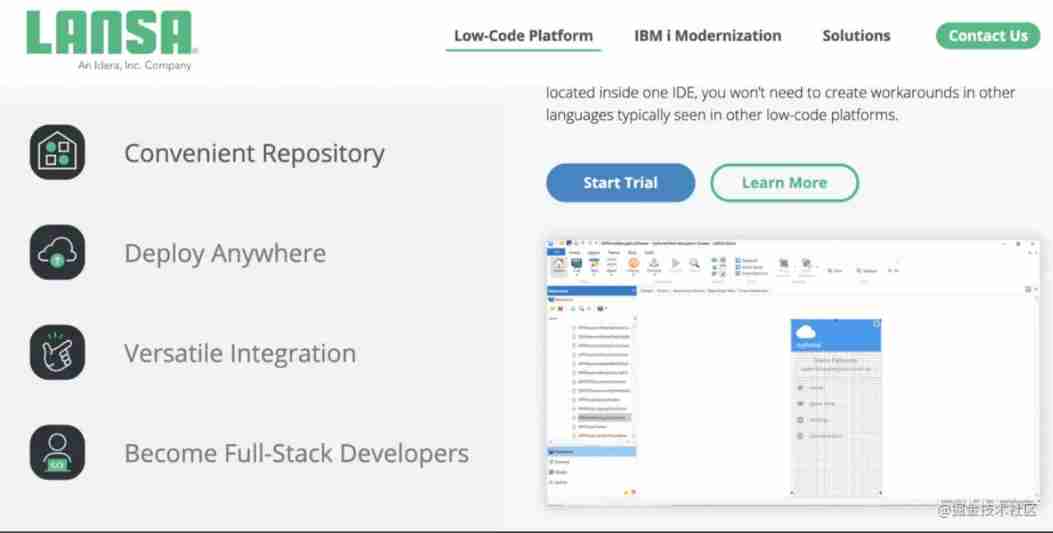
Apaas platform of TOP10 abroad

【三层架构及JDBC总结】
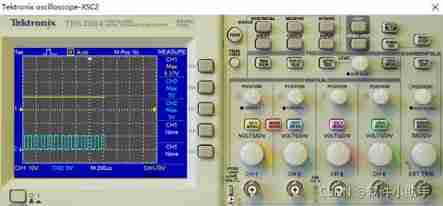
Charge pump boost principle - this article will give you a simple understanding

猜谜语啦(9)
![[three tier architecture]](/img/73/c4c75a453f03830e83cabb0762eb9b.png)
[three tier architecture]
![[noi simulation] juice tree (tree DP)](/img/19/bc71e8dc3958e4cb87b31423a74617.png)
[noi simulation] juice tree (tree DP)
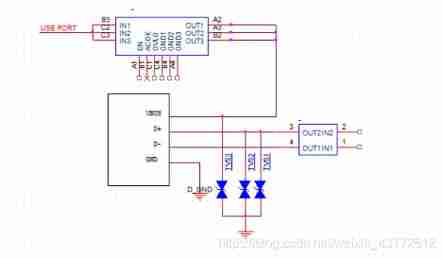
Talk about the circuit use of TVs tube
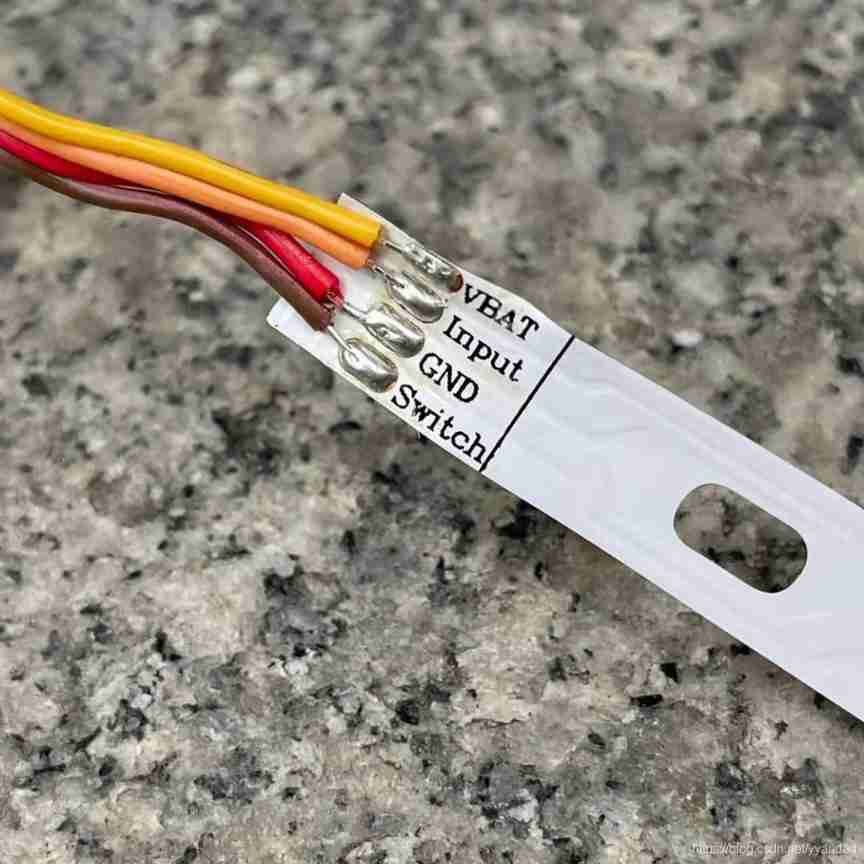
Old Wang's esp8266 and old Wu's ws2818 light strip
随机推荐
Meizu Bluetooth remote control temperature and humidity access homeassistant
Summary of SIM card circuit knowledge
Matlab tips (28) fuzzy comprehensive evaluation
Google sitemap files for rails Projects - Google sitemap files for rails projects
Weidongshan Internet of things learning lesson 1
Basic information commands and functions of kernel development
【NOI模拟赛】汁树(树形DP)
如何写Cover Letter?
Arduino operation stm32
leetcode - 445. Add two numbers II
Anonymous structure in C language
MySQL之MHA高可用集群
Old Wang's esp8266 and old Wu's ws2818 light strip
UE像素流,来颗“减肥药”吧!
[cloud native | learn kubernetes from scratch] III. kubernetes cluster management tool kubectl
Working principle and type selection of common mode inductor
Stm32--- systick timer
Naming rules for FreeRTOS
PIP installation
Simple design description of MIC circuit of ECM mobile phone